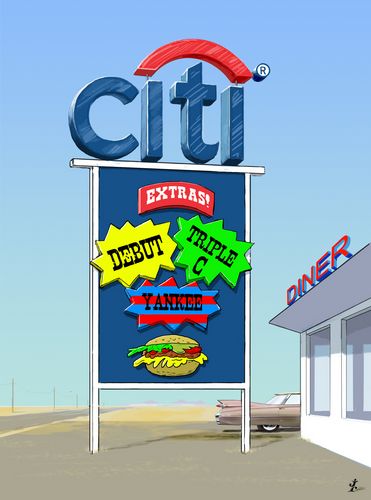The full menu
One bank has dominated the debt capital markets this year. And while much of that dominance is thanks to its achievements in its US home market, it has proven its credentials across the globe. That bank is Citigroup, which is IFR’s Bond House, US Bond House, North America Financial Bond House and Latin America Bond House of the Year.
Winning a title is hard; successfully defending it is tougher. Yet Citigroup has proven its resilience by winning IFR’s Bond House of the Year for the second year in succession.
“We’ve backed up last year with a stronger performance this year,” said Phil Drury, head of EMEA capital markets at the firm.
No other bank is as consistent as Citigroup, be it across key markets or products. More international than JP Morgan, better in the US than HSBC, Citigroup outshines its key rivals.
And in a year that has been marked by low volatility, albeit punctuated by what Drury describes as “cliff headline risks”, Citigroup has been able to take advantage of the long issuance windows.
“It’s been about pushing boundaries,” said William Weaver, head of EMEA debt capital markets.
In Europe, for example, Citigroup helped the corporate hybrid market spring back to life with a dual-currency transaction, comprising €900m and SKr6.5bn (US$769m) tranches, for Nordic telecoms company Telia. Priced in late March, it was the first euro benchmark corporate hybrid of the year.
In the financials sector, the bank was on a number of milestone capital trades, including Nationwide Building Society’s core capital deferred shares trade, Bank of Ireland’s dual-tranche Tier 2 issue through its newly established group holding company, and a debut Investec AT1.
And while issuance in the SSA sector was more prosaic than in recent years, Citigroup was at the forefront of some of the leading trades – Greece’s return, the IFC’s debut Social bond and rare 10-year US dollar benchmarks for supranationals such as the ADB, EIB and IDB.
“Across our businesses, issuers come to us as they trust us to do something a little different,” said Peter Charles, head of EMEA fixed income syndicate.
SHINING BRIGHTEST
The market where Citigroup has shone brightest is its home one, winning IFR’s US Bond House of the Year award. In a year characterised by bonds that were priced the tightest, or were the largest or longest, Citigroup differentiated itself by finding a lead role on almost all the landmark deals and bringing creative solutions to a wide variety of clients.
The bank raced to the top three of the league tables across asset classes on the back of a strong showing in the US dollar corporate bond market.
In a high-grade market that saw a seventh consecutive year of record issuance volumes, Citigroup’s global reach, balance sheet, and ability to deliver for its clients – both in public and private markets – made it a clear standout.
Though execution risk was minimised by liquidity pouring into the asset class from around the world, there were still bumps in the road such as political uncertainty around the US elections, the new government’s inability to push through reforms, and the prospect of higher rates and upcoming tax reforms, all of which Citigroup navigated very efficiently.
The bank was actively involved in a number of transactions that included some cookie-cutter refinancing trades, first-time borrowers and large acquisition financings.
Its global presence and distribution capabilities meant it found a role on a number of bond issues from large corporate brand names and banks, some of which set new benchmarks.
Teachers Insurance and Annuity Association of America, IBM Credit, Digital Realty, UniCredit, Costco and Walmart were on Citigroup’s roster of clients that were visiting the US dollar bond markets for the first time or after many years’ absence.
Multinationals such as PepsiCo, Walt Disney, Ford Motor Company, eBay, Procter & Gamble, Mastercard, Caterpillar, American Express, Toyota, Boeing, BP, AT&T, British American Tobacco and Honda Financial Corp, also trusted Citigroup as a bookrunner on their trades during the review period.
“The world’s most influential, valuable and iconic companies leaned on Citigroup’s global platform to drive the best advisory and execution experience,” said Peter Aherne, head of North America capital markets.
Global distribution became critical for many issuers during market volatility to maintain sufficient pricing leverage and achieve investor diversification.
CAPITAL STRENGTH
In the financials sector, the bank led regulatory-efficient capital offerings from issuers including Westpac, CapitalOne, BNY Mellon and Farmers Insurance, showcasing its ability to structure capital deals customised to help companies achieve regulatory goals.
Citigroup also priced multiple first-of-its kind TLAC-efficient structures that were replicated by other borrowers. The first was a fixed-to-floating senior callable security in January, an 11-year non-call 10 that set a precedent on how to determine the back-end spread on fixed-to-floating senior bond issuance.
The bank used the swap rate to the call date to calculate the back-end spread. An upward sloping swap rate would dictate that using a swap rate to the maturity date would render a lower back-end spread rather than using a swap rate to the call date. This change ensured strong interest in the bonds.
These deals helped Citigroup win North America Financial Bond House.
The broadening of Citigroup’s reach across corporates also paid off in US high-yield, where the bank led a diverse mix of financing and picked up new clients.
“This is probably our strongest and broadest showing post-crisis,” said John McAuley, Citigroup’s co-head of US leveraged finance.
“We want to be in front of CFOs, CEOs, board members and treasurers of every company that has at least US$1bn of debt.”
The US bank jumped two spots to fourth place in Thomson Reuters league tables with a 7.7% market share.
Citigroup was lead-left on bond sales for high-profile issuers such as Transocean, Valeant and Liberty Global, among others, stepping into the territory of competitors that had well-established relationships with those issuers.
It also went where other banks appeared more hesitant to go, successfully leading a rare 30-year bond sale for hospitals company HCA, which was mostly sold to high-yield investors rather than the high-grade buyers typically targeted for longer tenors.
And speaking of crossover trades, it would be hard to ignore Nokia’s US$1bn two-part bond sale – its first foray into the US dollar bond market in eight years – which was also led by Citigroup.
The last time the Finnish company sold bonds in US dollars, the iPhone was only in its second year of life and Nokia itself still had investment-grade ratings.
BIG MAC WITH NO CHEESE
In structured finance, Citigroup branched out further.
It cemented its leadership in the flow business but also played a bigger role in more esoteric asset classes where it helped create new platforms.
“Senior management asked why we were so good at what we know, but why we weren’t doing more,” said Amanda Magliaro, Citigroup’s head of global structured finance distribution.
“The thought was: we make a great Big Mac, but we also want to be the Big Mac with no cheese. We want to deliver anything.”
Citigroup took leadership very early on in the year by addressing one of the biggest hurdles for the flow business: how to comply with new regulations.
Everyone was waiting for Ford Motor to make the first move, and sure enough it eventually did, with Citigroup as structurer.
The Ford trade was the first public auto ABS deal to comply with both risk-retention and loan level disclosure with regards to Regulation AB II, and paved the way for others to follow.
EM CONSISTENCY
Citigroup is more than just a US machine, however. Take its emerging markets franchise; the bank is number one in the league tables. “We’re consistent across all the regions,” said Charles.
In emerging Europe, the Middle East and Africa, Citigroup, along with JP Morgan, dominated, with deals across the product spectrum. Debut borrower Tajikistan, Iraq’s comeback trade and Belarus’s first 144A deal stood out.
All involved a lot of work behind the scenes to ensure that all the relevant parties, from paying agents to clearing houses, were comfortable.
Belarus, in particular, was a delicate trade to manage given the political sensitivities of bringing to market a country whose president is subject to US sanctions.
In Asia, Citigroup was the nearest challenger to HSBC, showcasing its talents across investment-grade, high-yield, infrastructure financing and liability management.
But arguably the region where Citigroup had its greatest success in 2017 was Latin America, where it wins the IFR Latin America Bond House award.
“There were real opportunities in 2017, and we took advantage of that to go where few had gone before,” said Chris Gilfond, head of Latin America capital markets origination.
With about US$20bn of cross-border bond proceeds credited over the awards period, the US bank captured an impressive 14.8% market share, according to Thomson Reuters data.
That put Citigroup head and shoulders above its competitors with the exception of JP Morgan, which came closely behind with US$18.16bn of proceeds for a 13.6% market share.
“Relative to last year we finished number one, our lead relative to our peer group has grown a full three percentage points in market share pro rata to each bookrunner,” Gilfond said.
“When you are leader it is hard to pick up that incremental share.”
This was where Citigroup’s broad geographic reach played out well.
An almost exclusive lock on Ecuadorian sovereign mandates certainly served it well after the country selected it as a sole lead on four of the five deals brought to market over the awards period.
The bank was also sole lead on an innovative trade of Petroamazonas bonds that allowed suppliers to monetise securities that had been used as payment by the oil company.
Belize also retained Citigroup as structuring adviser on the country’s third restructuring in a decade.
Yet Citigroup didn’t limit itself to off-the-run countries.
It not only captured business from Argentina to Mexico, but was involved in deals from liability management to project finance and the resurgence of local currency trades.
These included a jumbo new issue and exchange from Brazil’s Petrobras that targeted more than US$14bn of bonds, a structure that allowed the debt-laden company to avoid the significant one-off costs of prior liability management operations.
It was among the lead underwriters for Argentina’s debut US$2.75bn Century bond, the largest-ever deal of that maturity at the time and first from a full junk issuer.
Pulling off a 100-year trade is a landmark event for any issuer, but it is true head-turner for a country that was in technical default just over a year ago.
“It is the shortest time lag from default to a 100-year that we will probably ever see,” said Gilfond.
To see the digital version of this review, please click here.
To purchase printed copies or a PDF of this review, please email gloria.balbastro@tr.com.



